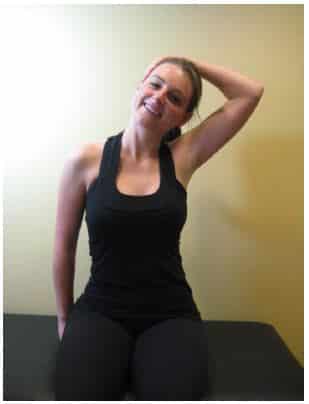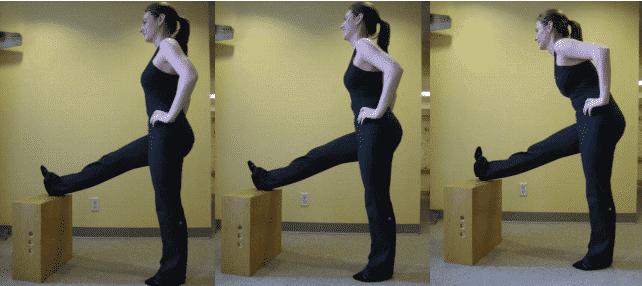Middle Scalene Stretch
Duration :1 Minute
Instructions:

- Sitting erectly, sit on the hand of the side you desire to stretch.
- Reach over your head, and pull gently, in a rainbow like fashion, away from the hand you are sitting on. This stretch is especially important for patients with Thoracic Outlet Syndrome, and should be done in conjunction with the Anterior Scalene Stretch, also accessible through our website.
- Hold the position for a minimum of 10 seconds; stop if you feel pain or dizziness.
STRETCHING OCCURS OVER TIME. DOING ONE STRETCH ONCE A MONTH WON’T DO THE JOB!
Hamstring Stretching Self Help
Duration :1 Minute
Instructions:

- Find a stable object approximately 18” off the ground.
- Place your heel of the side you are stretching on it, standing as erectly as possible.
- Extend your belly, and imagine an axis through your hips, and bend forward.
- Gently stretch your hamstrings muscles; if you feel like you have to bend more than you would like, flex your foot back towards you.
- Hold the stretch for approximately 8-10 seconds. Repeat 3-5x , every hour.
STRETCHING OCCURS OVER TIME. DOING ONE STRETCH ONCE A MONTH WON’T DO THE JOB!
The best dog collar from a chiropractic perspective.
We have a new dog, and I was wondering what the best dog collar would be for her from a chiropractic perspective. A traditional collar is exactly that, a belt that surrounds the cervical spine. Would I EVER do that to my patients? NO. WAY.
This "lead" me to look at collars that give way when pulled on, and the best of them is made in Germany , with some Chinese knock offs. The Sprenger dog collar is the best collar for walking the dog, as it closes on the neck, not nough to hurt the animal, but enough to get their attention. Since it closes AROUND the neck, not just pulling on one side of it,l it's the best method for training the dog. Admittedly, the dog can't live all the time with spikes poking into it's neck, so it needs to be taken off when in the house, when going out it's definitely the best one one out there. The collar should be in contact with the skin, tight enough that the neck reopens the collar after you tug lightly on it. Too loose, and it may not release. Also, place the collar lower on the neck, as the dog's 1st cervical vertebra is huge, and it may be really uncomfortable for them if it's up high on the neck. Any questions about dog collars? Email us!

How important is sleep?
I learned some interesting things about sleep a while back:
~ Humans are the only mammals on earth that actually willingly delay sleep.
~ Sleep apnea, a condition where you actually stop breathing, is the most common cause of sleep disruption. It affects 90 million Americans, and is easily diagnosed.
~ People used to sleep in segments. Before the invention of electricity, rather than sleeping through the night many people would sleep for a few hours, wake up, read, write, pray, or reflect, and then got back to sleep for another few hours before waking up for the day. This is reflected, believe it or not, in a 24 hour day. Why?
24 id divisible by :1, 2, 3, 4, 6, 8, 12, and 24. That's a lot of different shifts to work!
~ All-nighters are not good. Being awake for 16 hours in a row, your mind’s ability to function is impaired, similar to the feeling when you have a blood alcohol level of .05%.
~ Color TV's changed the way we dream. Prior to color film, only 15% percent of people dreamed in color. Now, 75% of people dream in color.
~ Higher altitudes increase the chance of sleep disruption. Because there's less oxygen in the air, you’re more likely to wake because of an issue with your breathing.
~ You can control your dreams. It’s called lucid dreaming and it involves becoming aware that you are dreaming, but not letting your mind wake itself up.
Three dimensional stretching... part one.
Too often we think about muscles as being only one dimensional and working in only one direction. We are taught the origins and insertions of them, their actions and innervations, but we lose sight of what they actually are… muscles are not strings that tighten, but instead able to move in three dimensions. When we stretch a muscle group in only one plane, we forget that there is an x, a y and z axis that are left unstretched. Is it any wonder why we can’t see any changes with the stretches we give our patients?
So let’s start with the muscles themselves.Muscles are comprised of myofilaments, and are ordered into strands called fascicles. (fascicles are derived from Latin faces, which was a bundle of iron rods, bound by ribbon, used as a sign of absolute power, and can still be seen outside US government buildings, and the rise of the word fascist)
The point of this entry is not to wow you with trivia about muscles, but instead to get you to think about muscles in a different way: Simply put, muscle tissue is not singly dimensional, and therefore shouldn’t be stretched in only one plane.
This is especially true with muscles that have the suffix “-ceps” in them… triceps, biceps, quadriceps… their very name tells you that there is more than one head attachment which requires a different plane to work in. This is also the case where there is a “major” or “minor” ending, as well.
When showing stretching to my patients, I often describe these planes as around each axis, where each plane needs to be stretched around.
Perhaps nowhere in the body is the concept of 3 dimensional muscles better found than that of the iliopsoas muscles, which most people refer to simply as the “psoas”. Nothing could be farther from the truth.
The iliacus inserts around the entire rim of the pelvis, forming a nearly 90 degree angle from one insertion point to another! The psoas major and minor attach to the lumbar vertebrae, and to the discs at each level, with each head requiring a different plane of stretching to address altogether.
This stretch is the most important first point of addressing lumbar stenosis, outlined on the website.
Tylenol deemed not effective for low back pain?
There has been more and more information coming out about Tylenol lately, and none of it is good.
Last year studies showed Tylenol use by expectant mothers increasing the odds of having a child with ADD/ADHD like behaviors.
There was also a study showing an association between giving children Tylenol post vaccination and autism. So until those issues are completely ruled out, it looks to be no good for children or expecting moms, which probably means it's not that good for anyone!
Well now new evidence is out that suggests that Tylenol is not effective for lower back pain or osteoarthritis (the most common type). The results come from looking at 13 RCT studies. These findings may change the guidelines that currently recommend acetaminophen as the first analgesic option. Tylenol is currently the most common OTC analgesic used worldwide.
The authors of the study note that non-pharmacological pain relief methods should be the primary forms of treatment going forward. I could name one very effective approach.... it's called chiropractic.
So these findings also bring up a new question. What is Tylenol good for anyway?
For more information click https://www.sciencebasedmedicine.org/tylenol-may-not-be-as-safe-and-effective-as-we-thought/
An interview with a chiropractor's son.
Yesterday, I interviewed Conner Carr, my son, and asked him a couple of questions about his stance on chiropractic and life. It's quite interesting what he: knows about chiropractic, what he doesn't, and just how 10 years old he is! *
*There have been some difficulties in loading the interview, trust me, it's coming.
So this is the first time I've uploaded a blog entry via sound file directly to my website; please be patient as I navigate the Internet!
This is a test, it is only a test.
We're testing to see if our blog, or WHEN our blog, is recognized by Google. We'll post the time when it gets seen!

Our first blog-- podcast about chiropractic, and Harvey Lillard's gravesite
It's totally worth checking out our new podcast site, where we (Dr. Brad Ulrich and I) discovered Harvey Lillard's gravesite. Who knew that he was A: Buried in Seattle? and B: So accessible? Thank you Harvey, (or should I say William Harvey?) for being brave. Thank you, D.D. Palmer, for being so crazy as to think the nervous system might be affected by the musculoskeletal system. D.D., you rock.
Harvey Lillard Gravesite interview.. first chiropractic patient!
You're doing it wrong-4 Worst exercises for working out
 The elliptical machine is a godsend for a lot of gym goers: it's smooth, it's not too nerdy, it feels like something approximating a normal motion. And for many it is, but for a pretty large percentage of people, it's absolutely awful. The reason is quite simple: the elliptical machine has a pivot point that may be too small or large for a large number of users. If so, it forces the lumbar spine to flex and rotate through the cycle. Flexing and rotation of the lumbar spine is NOT a good thing, and WILL decay the discs of the lumbar spine. A video analysis of the low back during this activity will show the issue right away. If there's motion in the lumbar spine, it's TIME TO STOP. Use the treadmill instead.
The elliptical machine is a godsend for a lot of gym goers: it's smooth, it's not too nerdy, it feels like something approximating a normal motion. And for many it is, but for a pretty large percentage of people, it's absolutely awful. The reason is quite simple: the elliptical machine has a pivot point that may be too small or large for a large number of users. If so, it forces the lumbar spine to flex and rotate through the cycle. Flexing and rotation of the lumbar spine is NOT a good thing, and WILL decay the discs of the lumbar spine. A video analysis of the low back during this activity will show the issue right away. If there's motion in the lumbar spine, it's TIME TO STOP. Use the treadmill instead.
Also, you aren't burning the calories you think you are, as the caloric output is based on the spinup phase of the flywheel, not the maintenance of momentum.... which means you're burning only about a 1/6th of what it says.
